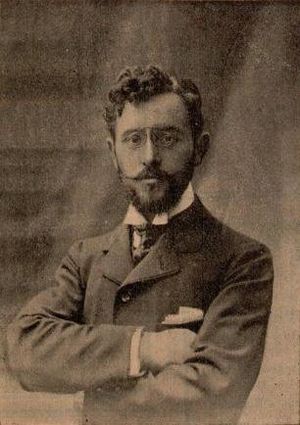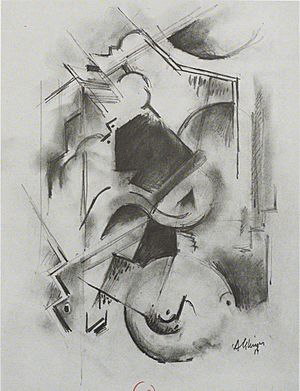Florent Schmitt facts for kids
Quick facts for kids
Florent Schmitt
|
|
|---|---|

Schmitt in 1900
|
|
| Born | 28 September 1870 Meurthe-et-Moselle, France
|
| Died | 17 August 1958 Neuilly-sur-Seine, France
|
| Occupation | Composer |
Florent Schmitt (born 28 September 1870 – died 17 August 1958) was a famous French composer. He was part of a group of artists called Les Apaches. His most well-known pieces are La tragédie de Salome and Psaume XLVII (Psalm 47). People have called him "one of the most interesting of France's lesser-known classical composers."
Contents
Biography
Early life and career
Florent Schmitt was born in Meurthe-et-Moselle, France. He started taking music lessons in Nancy with a local composer named Gustave Sandré. When he was 19, he joined the Paris Conservatoire. There, he studied with important teachers like Gabriel Fauré and Jules Massenet.
In 1900, he won the Prix de Rome, a famous award for artists. In the 1890s, he became friends with Frederick Delius, another composer who lived in Paris. Schmitt even helped Delius by preparing music scores for some of his operas.
From 1929 to 1939, Schmitt worked as a music critic for a newspaper called Le Temps. He was known for being very outspoken. He would sometimes shout his opinions from his seat during concerts!
Later life
Florent Schmitt was one of the most performed French composers for many years. But later in his life, his music became less popular. This was partly because of his support for the Nazi party in the 1930s. He also worked with the Vichy government in the 1940s. Other famous French musicians also did this.
In 1952, he received a high honor called the Légion d'honneur. Even though his music was less known, he never stopped composing.
Later, people looked more closely at Schmitt's early career. This happened when a book was written about the English composer Frederick Delius. Schmitt had been one of Delius's few French musician friends in Paris.
In 1956, Schmitt traveled to England. He met with Sir Thomas Beecham, who was writing the book about Delius. While in England, Schmitt also reunited with Ralph Vaughan Williams, another famous composer. They hadn't seen each other in over 50 years!
Florent Schmitt passed away in Neuilly-sur-Seine in 1958, at the age of 87. He had traveled to a music festival shortly before his death to hear his Second Symphony performed.
Music

Florent Schmitt wrote 138 musical pieces with special opus numbers. He composed almost every type of music, except for opera. His Piano Quintet in B minor, written in 1908, helped him become famous. He also wrote a violin sonata, a string quartet, and music for a wind band called Dionysiaques. He wrote two symphonies and several piano pieces like Crépuscules and Mirages.
Schmitt was part of a group of artists called Les Apaches. His music style was like Impressionism, similar to Debussy. But it also had influences from composers like Richard Wagner and Richard Strauss.
In 1907, Schmitt wrote a ballet called La tragédie de Salomé. It was originally for a small group of instruments and lasted about an hour. Later, in 1910, he made a shorter version for a much larger orchestra. This shorter version is more famous today. It has been recorded by many conductors, including Schmitt himself. This ballet's rhythms and sounds were very new and exciting. They even seemed to predict some of the music in Stravinsky's famous ballet, The Rite of Spring.
In 1927, Schmitt was one of ten French composers who each wrote a dance for a children's ballet called L'éventail de Jeanne. Schmitt wrote the final dance, a Kermesse-Valse.
In recent years, more people have become interested in Schmitt's music. Many of his compositions are now available on compact disc.
Main works
Orchestral
- 3 symphonies:
- Symphonie concertante, Op. 82 for orchestra and piano
- Second Symphony, Op. 137
- Janiana symphony for strings, Op. 101
- Antoine et Cléopâtre, Op. 69 (1919-20)
- Enfants, Op. 94
- Introït, récit et congé, Op. 113 for cello and orchestra (1949)
- Kermesse-Valse from L'éventail de Jeanne (1926)
- Le Palais Hanté [The Haunted Palace] (1904)
- Le Petit Elfe Ferme-l'œil, Op. 73
- Légende, Op. 66 for alto saxophone (or violin, or viola or alto) and orchestra
- Salammbô (film music)
- Salammbô (3 suites)
Chamber music
- Pour presque tous les temps for flute and piano trio, Op. 134
- Saxophone Quartet, Op. 102
- Flute Quartet, Op. 106
- String Quartet, Op. 112
- Piano Quintet in B minor, Op. 51 (1902–08)
- Sonata for violin and piano
- Trio sonatina for flute, clarinet and keyboard, Op. 85
- String trio, Op. 105
- Suite en rocaille, Op.84
- Suite for trumpet and piano, Op. 133
- Légende for alto saxophone and piano, Op. 66
Vocal
- Le chant de nuit for soloists, chorus and orchestra
- Mass for four voices and organ
- Psaume XLVII for soprano, chorus, organ and orchestra (1906)
Wind Band
- Dionysiaques, Op. 62 for military band (1913/25)
Ballets
- La Tragédie de Salomé (1907)
- Oriane et le prince d'amour
Piano
- Reflets d'Allemagne, Op. 28 (1905)
- Musiques foraines, Op. 22
- Feuilles mortes, Op. 46
- Crépuscules, Op. 56
- Ombres, Op. 64
- Mirages, Op. 70
See also
 In Spanish: Florent Schmitt para niños
In Spanish: Florent Schmitt para niños

